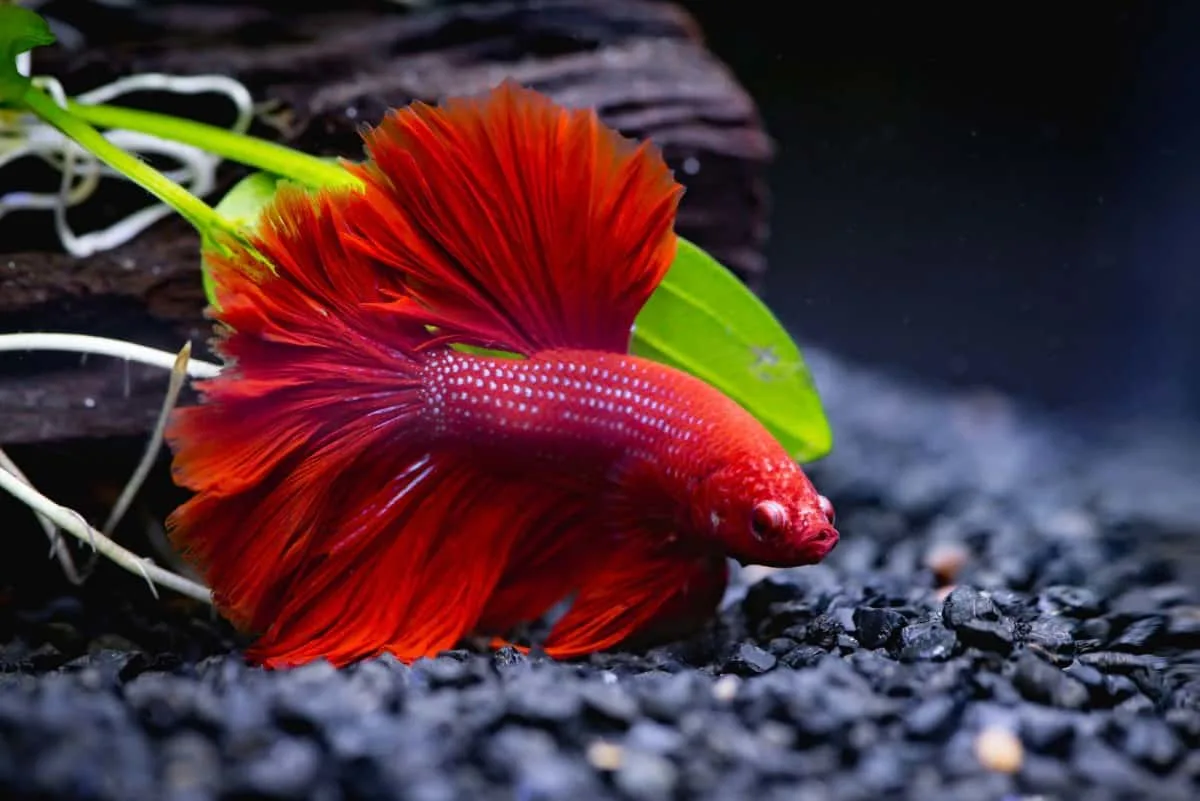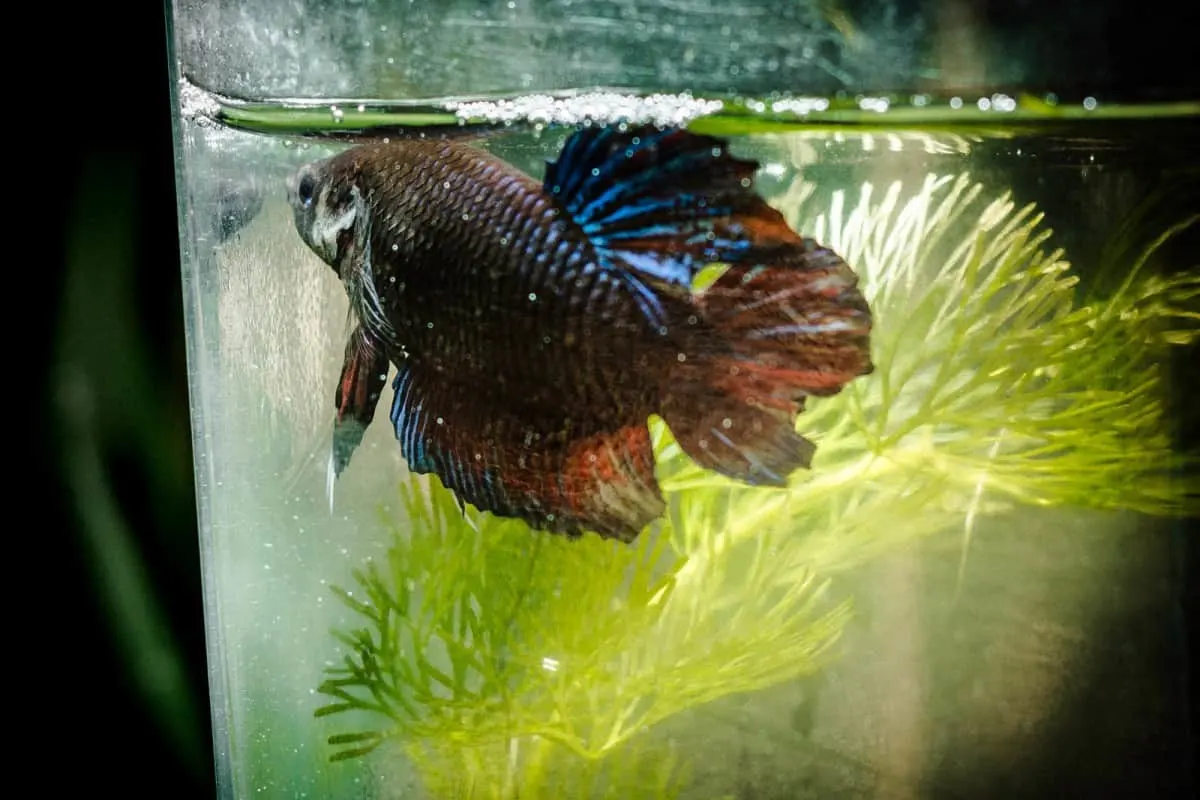
More than once, I caught my Betta fish hovering at the upper sections of the tank. That got me curious since these fish typically swim in the middle. Admittedly, I wanted to know if that behavior could indicate an issue. That was when I began to research the topic a little deeper.
Betta fish tend to sit at the upper sections of the tank and gasp for air due to oxygen deficiencies, mostly secondary to inadequate water temperature. However, upward swimming may also be a result of a shortage of food, crowded conditions, and bladder issues.
As we move forward in this article, I will show you how to prevent your Betta fish from suffering, and as a consequence, swimming upwards. Moreover, I will share with you a few signs that may indicate your Bettas are in lousy shape and possibly dying.
What Makes Bettas Sit at the Top?
People tend to keep betta fish because they are beautiful and active. However, like most fish, they do not always act as predicted. For instance, the average Betta spends most of its time in the middle of the tank.
The species will occasionally swim through the upper and lower sections. However, it spends most of its time in the middle. Therefore, if your Bettas are sitting at the top of your aquarium for long durations, you should ask yourself why.
That is by no means normal behavior. Some of the most common causes of such habits in Bettas include:
1. Low Oxygen Concentrations

Bettas differ a bit from other fish. Most fish use their gills to extract oxygen from water. They cannot breathe through their mouths like humans. Bettas have gills that permit them to breathe underwater. However, they also have a so-called labyrinth organ that works like a lung.[1]
This particular structure allows them to breathe air and oxygen, just like a human. In other words, Bettas can survive outside water, but only for a short time. Also, they must remain moist during this period.
If your Betta fish is spending a lot of time at the top, your tank is probably suffering from an oxygen deficiency. Bettas that are escaping the lack of oxygenation might stick their mouth out of the water every so often.
Even if it is merely swimming within the top section of the tank, this area has more dissolved oxygen than the bottom. You shouldn’t rule out an oxygen deficiency simply because your Bettas do not breathe air directly.
Also Read: Why Is My Betta Breathing Heavily?
2. Inadequate Water Parameters
Bettas require specific parameters to survive. You need to keep their water at a temperature ranging between 75 and 80 degrees F.[2] The pH should range between 6 and 8. You are also expected to keep the nitrites and ammonia levels at zero, not to mention keeping the nitrate levels below 20.
Poor water quality can threaten the health of your fish. Bettas are hardy creatures, but if they are exposed to unhealthy concentrations of toxins like ammonia, not to mention the wrong pH, the resulting discomfort will compromise their health.
That will cause distress and drive them towards the top in an attempt to escape the punishment below. Some fish have been known to jump out of their tanks to escape the less-than-ideal parameters in the aquarium.
There are two considerations to make where the temperature is concerned. If the water is too cold, your Bettas will run to the top where conditions are almost always warmer. That primarily happens in large tanks during the summer.
On the other hand, if the water is too warm, oxygen levels in the middle and at the bottom will plummet in response. This will also drive the Betta to the top where oxygen is more abundant. That is why sticking to the required temperature range is vital.
3. Crowded Conditions
If your tank is too small or if you have too many fish, your Bettas might swim to the top because they do not have the space to maneuver in the middle. Also, keep in mind that crowding can lead to conflict between fish.
If you have larger, more aggressive fish in the tank, the Betta might also flee to the top in response to the stress of being exposed to danger. That is more likely to happen if you haven’t introduced plants, rocks, and decorations to your tank.
Regarding population, the rule of thumb would be one gallon of water per inch of an adult fish.[3] Hence, the average Betta fish, which is 2-3 inches in length, requires 2-3 gallons of water. Two Bettas, for that matter, would need at least 4-6 gallons, and so on.
Also Read: Stress In Betta Fish
4. Lack of Food
Bettas are pretty intelligent fish. They know that they are typically fed from the top. If you have permitted them to go hungry for any reason, they will start swimming near the top in the hopes of finally being fed.[4]
They will also swim to the top in search of food, especially if they have checked everywhere else. You may suspect that conditions if your Bettas turn to the middle sections after feeding times. That could indicate that they have swum upwards in search of food.
5. Swim Bladder Issues
When a Betta has a swim bladder problem, it will have trouble swimming straight. After a while, it will turn on its side and float to the top. Swim bladder issues can manifest as a result of overfeeding, which can lead to constipation.
Besides swimming upwards, a constipated Betta will also begin to swell. You will even notice that its feces become stringy, hanging from its back. That is in contrast to healthy fish, in which the feces immediately fall to the substrate.[5]
How to Keep Your Bettas From Swimming at the Top?
If your Betta is being compelled to swim at the top by external factors, the only way to draw the fish back to the middle is to resolve them. Some practical steps that you can take in such situations include:
1. Elevate Oxygen Concentrations
If your Bettas are gasping at the surface, your tank doesn’t have enough oxygen. However, you can quickly solve this problem by adding an air stone.[6] It will increase surface agitation, allowing more oxygen to dissolve into the water (while also encouraging CO2 to escape).
Luckily, air stones are quite cheap. Here is the Aqua Fizzzz 1-inch Cylinder Air Stone (link to Marine Depot), which is sold for under $2. It will efficiently get the job done if your aquarium is relatively small (up to 15 gallons).
You can also procure more powerful powerheads that will create stronger currents in the water, making sure that the oxygen is evenly distributed throughout the tank. That is the more practical solution in high-volume tanks.
2. Adjust the Temperature
Whether high temperatures are to blame for the oxygen deficiency or low temperatures are forcing your Bettas to escape to the surface, you probably need a thermometer and a heater. You should strive to the desired range of 75 to 80 degrees F.
Lastly, endeavor to measure the temperature regularly to ensure that it is within the necessary parameters. Do not rely on the ambient temperature to maintain the conditions in your aquarium. Get one or more heaters that are powerful enough to keep the heat in the tank within the appropriate range.
3. Maintain High Water Quality
Test your water regularly to ensure that the nitrate, nitrite, and ammonia levels are within the desired range. For that, I highly recommend checking the API Reef Master Test Kit (link to Marine Depot). A five-minute work with that bundle could save you countless dead fish.
Moreover, try getting a reliable filter that will keep the water clean. Following that, perform regular water changes to remove waste and toxins. The rule of thumb is to replace a third of your tank once a week.
Lastly, make sure to remove dead plants. If you have decorations, take them out every so often and wash them. Soak them in bleach, use a brush to remove algae, and rinse thoroughly. If you don’t have one, get a vacuum siphon pump.
You can use it to clean the gravel and remove uneaten food and waste. You should know that Bettas cannot live in dirty, cloudy water (at least not for long). The only way to prevent them from escaping to the top is to keep the tank clean.
4. Get the Right Tank Size

Bettas need roughly ten gallons of water. However, the more fish you have, the larger the tank you’ll require. Try to match the size of your aquarium to the needs of your fish.
If you cannot afford to buy a new tank to accommodate all your fish, at least reduce their numbers. Give your Bettas as much space as they need. That will encourage them to swim freely in the middle sections of the tank.
5. Provide Hiding Places
Try not to keep Bettas in a bare tank. Add plants, rocks, and other decorations that Bettas can use to hide. This is particularly important for aquariums with bigger and more aggressive fish than Bettas.
If you can give your fish a place to hide when they are stressed, they are less likely to sit at the top. However, avoid decorations with sharp edges. They will quickly rip your Betta’s fins, exposing them to parasites and diseases.
6. Feed Your Bettas Properly
If your fish are going hungry because your schedule does not allow you to feed them on time and in the appropriate quantities, get an automatic feeder. It will ensure that your Bettas are supplied at the right time in the right amounts. This will combat constipation and swim bladder disorder.
A wise pick would be the Eheim Feed Air Automatic Feeder (link to Marine Depot). That device will ensure that your Bettas remain satiated by providing them with the precise quantities you’ve earlier defined.
However, if your fish are already constipated, don’t feed them for two or three days. Once their meals resume, give them boiled (and peeled) peas. This is a reasonably effective means of forcing the waste out of their bodies.
If you don’t have an automatic feeder, limit your Bettas to two meals a day to avoid overfeeding. If you keep noticing uneaten leftovers in the tank, you are probably giving them too much food.
How do I Know if my Betta is Dying?
All fish eventually die. Some of them perish from old age. Others are killed by diseases. But Bettas rarely die abruptly. They usually manifest signs and symptoms that will warn you that the worst is about to happen.
Your Betta’s decision to linger at the top isn’t always a cause for concern. Fish have different personalities, and some Bettas might simply prefer to stay at the top. You should only take action if your Betta’s decision to do so is accompanied by additional symptoms. For instance:
- Faded colors – You can tell that something is wrong with your Bettas by determining whether or not their colors are fading.[7] Some Bettas lose their colors because of stress. Old age can also play a part. But diseases are the most common cause (the more significant the color change, the more serious the illness).
- Inactivity – When Bettas are assaulted by elements such as illnesses, high ammonia concentrations, and old age, they will become lethargic.[8] Some of them start swimming slowly. Others stop swimming altogether. They will either hover in place or drop to the bottom.
- Misplaced Fins – The fins are one of the most prominent signs of a fish’s health. If your Betta’s fins are frayed or held close to the body, something has gone wrong.[9]
- Lack of appetite – Sick Bettas will lose their appetite. The same is valid for dying Bettas. If your Bettas show no interest in food, they are either constipated or suffering from a potentially fatal illness.
- Weight loss – If your Betta is losing weight and its stomach has become skinny, it might have contracted parasites that could kill it if they are left untreated.
- Dropsy – If you have observed pine coning scales and bloating in your fish, dropsy is a potential cause.[10] Most fish that suffer from this condition die. It is a consequence of kidney failure.
- Scratching – Healthy Bettas swim around the rocks and decorations in their tanks. If a Betta keeps scratching against the objects in the tank, it has contracted an illness that requires your immediate attention.
- Air gasping – If your Bettas are frequently gasping for air at the top, or if its gills show you that the creature’s breathing is labored, it is probably suffocating.
Conclusions
Betta fish may sit at the higher sections of the tank merely because they prefer to, and it doesn’t necessarily indicate an issue. However, warning signs such as lack of appetite, lethargy, and faded colors could mean that something is wrong.
In that case, upward swimming could be a symptom of an underlying issue. That is where you should check your water conditions and make sure they are adequate. Start with the water temperature, which is usually the case.
References
- https://www.aquascapeaddiction.com/articles/why-does-my-Betta-fish-keeping-swimming-to-the-top
- https://www.fishkeepingworld.com/Betta-fish/
- https://www.petco.com/content/petco/PetcoStore/en_US/pet-services/resource-center/health-wellness/why-is-my-fish-breathing-at-the-surface.html
- https://www.bettabuzz.com/why-your-Betta-fish-stays-at-the-top-of-the-tank/
- https://petcentral.chewy.com/aquarium-fish-constipation/
- https://fishkeepingforever.com/how-to-increase-oxygen-in-fish-tank/
- http://bettafishaquarium.com/how-can-you-tell-if-your-Betta-fish-is-dying/
- https://www.wikihow.com/Tell-if-a-Betta-Fish-Is-Sick
- https://petsoverload.com/is-my-Betta-fish-dying-how-do-i-know-if-my-Betta-is-sick/
- https://books.google.co.ug/books?hl=en&lr=&id=K5-HDwAAQBAJ&oi=fnd&pg=PR9&dq=signs+of+sickness+in+fish&ots=lZ6JNGcSsf&sig=3L7F3GAG0XNvrz1eMAXixcY2T4g&redir_esc=y#v=onepage&q=dropsy&f=false
